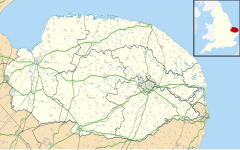|
Dilham
Dilham is a village and civil parish in the English county of Norfolk. The village is located 4.3 miles (6.9 km) south-east of North Walsham and 12 miles (19 km) north-east of Norwich, along the course of the River Ant. HistoryDilham's name is of Anglo-Saxon origin, and derives from the Old English for a farmstead or homestead with an abundance of dill.[1] In the Domesday Book of 1086, Dilham is listed as a settlement of 23 households in the hundred of Tunstead. In 1086, the village was divided between the estates of Alan of Brittany, Robert Malet, Roger Bigod and St Benet's Abbey.[2] Nearby Dilham Castle was built in the fifteenth century as a fortified manor house for Sir Henry Inglose; all that remains of the castle is the Grade II listed tower currently attached to Hall Farm.[3][4] During the Second World War, the North Walsham and Dilham Canal was designated as a line of defence against a possible German invasion which meant that bunkers, barbed wire and mortar-emplacements were built in the parish.[5][6] GeographyAccording to the 2021 census, Dilham has a population of 331 people which shows a small increase from the 319 people recorded in the 2011 census.[7] Dilham marks the limit of Broads navigation for larger boats, but smaller boats can continue on the North Walsham and Dilham Canal until Honing. St. Nicholas' ChurchDilham's parish church is dedicated to Saint Nicholas and was re-built in the 1930s. St. Nicholas' is located outside of the village on Church Road.[8] GovernanceDilham is part of the electoral ward of Hoveton & Tunstead for local elections and is part of the district of North Norfolk. The village's national constituency is North Norfolk, which has been represented by the Liberal Democrat Steff Aquarone MP since 2024. War MemorialDilham's war memorials are two marble plaques inside St. Nicholas' Church. The memorials list the following names for the First World War:[9][10]
And, the following for the Second World War:
References
External linksWikimedia Commons has media related to Dilham. |
|||||||||||||||||||||||||||||||||||||||||||||||||||||||||||||||||||||||||||||||||||||||||||||||||||||||||||||
Portal di Ensiklopedia Dunia

